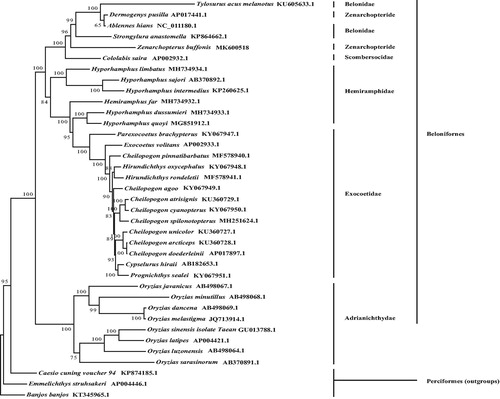Abstract
The complete mitochondrial genome of Buffon’s river garfish Zenarchopterus buffonis from South China Sea has been obtained for the first time. It is 16,462 bp long, and contains 21 tRNA genes, 2 rRNA genes, 13 protein-coding genes (PCGs), and 1 control region. The overall base composition is significantly biased (A, G, T, and C was 33%, 12.94%, 29.78%, and 24.27%, respectively) with A + T contents of 62.79%. In total, most PCGs use the initiation codon ATG except COX1 uses GTG. Seven PCGs have a complete codon TAA or TAG, whereas the other six genes end with the incomplete stop codon T–– or TA–. Phylogenetic analysis showed that Z. buffonis forms a monophyletic cluster with the species of Belonidae, Zenarchopteridae, and Sconberesocidae.
Buffon’s river garfish Zenarchopterus buffonis, commonly known as a halfbeak, is a species of fish in Zenarchopteridae. It is non-commercial fish inhabiting the surface levels of rivers, estuaries, and coastal waters, which has an extensive distribution throughout the Indo-West Pacific region, extending from India, southeast Asia to northern Australia (Hanif et al. Citation2017). Buffon’s river garfish is an edible fish in Southeast Asia countries which can grow up to 23 cm in length according to FishBase data. Here, several studies involving the biology of Z. buffonis have been reported, such as the mating behavior (Kottelat and Lim Citation1999), habitat preferences (Ikejima et al. Citation2003), the structure of the pharyngeal jaw apparatus (Tibbetts and Carseldine Citation2004), genetic variation (Lewallen et al. Citation2011), morphometric variation (Syaifullah et al. Citation2015), and enzymatic digestion (Abidin et al. Citation2016). No reports on its complete mitochondrial genome data are announced yet.
The specimens were collected from Xinying wharf of Lingao, Hainan province, China (N19°53′14.46″, E109°31′19.60″), and stored in Qionghai research base of Hainan Academy of Ocean and Fisheries Sciences. Muscle samples of Z. buffonis were preserved in absolute ethanol for total DNA extraction.
The whole mitochondrial (mt) genome of Z. buffonis is 16,462 bp in length (GenBank Accession No. MK600518). The total base composition was A (33%), G (12.94%), T (29.78%), and C (24.27%). The 62.79% of (A + T) showed great preference to AT. It consists of 21 tRNA genes, two rRNA genes, 13 protein-coding genes (PCGs), and 1 control region (D-loop). Except for ND6 gene and seven tRNA genes, other genes are encoded by the heavy strand.
The 21 tRNA genes vary from 65 to 75 bp in length. The 12S rRNA is 940 bp in length and located between tRNA-Phe and tRNA-Val; the 16S rRNA is 1598 bp in length, located between tRNA-Val and tRNA-Leu. Most PCGs use ATG as the start codon except COX1 genes use GTG. Seven PCGs were terminated with the complete stop codon: ND1, COX1, ATP6, ATP8, ND4L, and ND5 ended with TAA; ND6 gene stops with TAG, whereas other six PCGs ended with incomplete stop codon; COX2, COX3, ND4, and CYTB ended with T, ND2; and COX3 stops with TA. The control region is 799 bp in length located between tRNA-Pro and tRNA-Phe. Additionally, a (T)12 microsatellites were identified in the control region using MISA, its instability may affect mitochondrial replication, transcription, and evolution.
The phylogenetic tree was constructed based on the analysis of 13 PCGs encoded by 37 Beloniformes genomes available in GenBank by maximum likelihood (ML) method with 1000 bootstrap replicates. The result () supports that Z. buffonis forms a monophyletic cluster with Dermogenys pusilla, Ablennes hians, Tylosurus acus, Strongylura anastomella, and Cololabis saira. The topology relationships of Beloniformes was consistent with the previous work (Cui et al. Citation2018), but the relationships among Belonidae, Zenarchopteridae, and Sconberesocidae is still not clear, which required more mitogenomes data to demonstrate in the future.
Disclosure statement
No potential conflict of interest was reported by the authors.
Additional information
Funding
References
- Abidin DAZ, Hashim M, Das SK, Rahim SM, Mazlan AG. 2016. Enzymatic digestion of stomachless fish Zenarchopterus buffonis. Aquacult Aquarium Conserv Legis 9:695–703.
- Cui L, Dong Y, Cao R, Gao J, Cen J, Zheng Z, Lu S. 2018. Mitochondrial genome of the garfish Hyporhamphus quoyi (Beloniformes: Hemiramphidae) and phylogenetic relationships within Beloniformes based on whole mitogenomes. PLoS One. 13:e0205025.
- Hanif M, Siddik MAB, Nahar A, Chaklader M, Fotedar R. 2017. A new distribution of the buffon’s river garfish, Zenarchopterus buffonis (Valenciennes, 1847) in the southern coastal rivers of Bangladesh. J Appl Ichthyol. 33:1211–1214.
- Ikejima K, Tongnunui P, Medej T, Taniuchi T. 2003. Juvenile and small fishes in a mangrove estuary in Trang province, Thailand: seasonal and habitat differences. Estuarine Coastal Shelf Sci. 56:447–457.
- Kottelat M, Lim KK. 1999. Mating behavior of Zenarchopterus gilli and Zenarchopterus buffonis and function of the modified dorsal and anal fin rays in some species of Zenarchopterus (Teleostei: Hemiramphidae). Copeia. 1999:1097–1101.
- Lewallen EA, Pitman RL, Kjartanson SL, Lovejoy NR. 2011. Molecular systematics of flying fishes (Teleostei: Exocoetidae): evolution in the epipelagic zone. Biol J Linnean Soc. 102:161–174.
- Syaifullah S, Fajri H, Roesma DI, Muchlisin ZA. 2015. Morphometric variations of halfbeak fish (Zenarchopterus buffonis) from estuary of West Sumatra, Indonesia. Aquacult Aquarium Conserv Legis. 8:168–176.
- Tibbetts IR, Carseldine L. 2004. Anatomy of the pharyngeal jaw apparatus of Zenarchopterus (gill) (Teleostei: Beloniformes)). J Morphol. 262:750–759.

